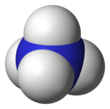Ammonium bifluoride
| |||

| |||
| Names | |||
|---|---|---|---|
| IUPAC name
Ammonium hydrogen fluoride
| |||
| Other names
Ammonium acid fluoride
Ammonium hydrofluoride | |||
| Identifiers | |||
3D model (JSmol)
|
|||
| ChemSpider | |||
| ECHA InfoCard | 100.014.252 | ||
| EC Number |
| ||
PubChem CID
|
|||
| UNII | |||
| UN number | 1727 | ||
CompTox Dashboard (EPA)
|
|||
| |||
| |||
| Properties | |||
| F2H5N | |||
| Molar mass | 57.044 g·mol−1 | ||
| Appearance | White crystals | ||
| Density | 1.50 g cm−3 | ||
| Melting point | 126 °C (259 °F; 399 K) | ||
| Boiling point | 240 °C (464 °F; 513 K)(decomposes) | ||
| 63g/100ml 20 °C | |||
| Solubility in alcohol | slightly soluble | ||
Refractive index (nD)
|
1.390 | ||
| Structure | |||
| Cubic, related to the CsCl structure | |||
| [NH4]+ cation: tetrahedral [HF2]− anion: linear | |||
| Hazards | |||
| GHS labelling: | |||
  [1] [1]
| |||
| H301, H314[1] | |||
| P280, P301+P310, P305+P351+P338, P310[1] | |||
| NFPA 704 (fire diamond) | |||
| Related compounds | |||
Other cations
|
potassium bifluoride | ||
Related compounds
|
ammonium fluoride | ||
Except where otherwise noted, data are given for materials in their standard state (at 25 °C [77 °F], 100 kPa).
| |||
Ammonium hydrogen fluoride is the inorganic compound with the formula NH4HF2 or NH4F·HF. It is produced from ammonia and hydrogen fluoride. This colourless salt is a glass-etchant and an intermediate in a once-contemplated route to hydrofluoric acid.
Structure
Ammonium bifluoride, as its name indicates, contains an ammonium cation (NH4+) and a bifluoride, or hydrogen(difluoride), anion (HF2−). The centrosymmetric triatomic bifluoride anion features the strongest known hydrogen bond, with a F−H length of 114 pm.[2] and a bond energy greater than 155 kJ mol−1.[3]
In solid [NH4][HF2], each ammonium cation is surrounded by four fluoride centers in a tetrahedron, with hydrogen-fluorine hydrogen bonds present between the hydrogen atoms of the ammonium ion and the fluorine atoms.[citation needed] Solutions contain tetrahedral [NH4]+ cations and linear [HF2]− anions.
Production and applications
Ammonium bifluoride is a component of some etchants. It attacks silica component of glass:
Potassium bifluoride is a related more commonly used etchant.
Ammonium bifluoride has been considered as an intermediate in the production of hydrofluoric acid from hexafluorosilicic acid. Thus, hexafluorosilicic acid is hydrolyzed to give ammonium fluoride, which thermally decomposes to give the bifluoride:
- H2SiF6 + 6 NH3 + 2 H2O → SiO2 + 6 NH4F
- 2 NH4F → NH3 + [NH4]HF2
The resulting ammonium bifluoride is converted to sodium bifluoride, which thermally decomposes to release HF.[4]
Ammonium bifluoride is also used as an additive in tin-nickel plating processes as the fluoride ion acts as a complexing agent with the tin, allowing for greater control over the resulting composition and finish.
Toxicity
Ammonium bifluoride is toxic to consume and a skin corrosion agent. Upon exposure to skin, rinsing with water followed by a treatment of calcium gluconate is required.[1] Poison control should be contacted.
References
- ^ a b c d Sigma-Aldrich Co., Ammonium bifluoride. Retrieved on 2013-07-20.
- ^ Greenwood, Norman N.; Earnshaw, Alan (1997). Chemistry of the Elements (2nd ed.). Butterworth-Heinemann. ISBN 978-0-08-037941-8.
- ^ Emsley, J. (1980) Very strong hydrogen bonds, Chemical Society Reviews, 9, 91–124. doi:10.1039/CS9800900091
- ^ Jean Aigueperse, Paul Mollard, Didier Devilliers, Marius Chemla, Robert Faron, Renée Romano, Jean Pierre Cuer (2005), "Fluorine Compounds, Inorganic" in Ullmann's Encyclopedia of Industrial Chemistry, Wiley-VCH, Weinheim. doi:10.1002/14356007.a11_307



